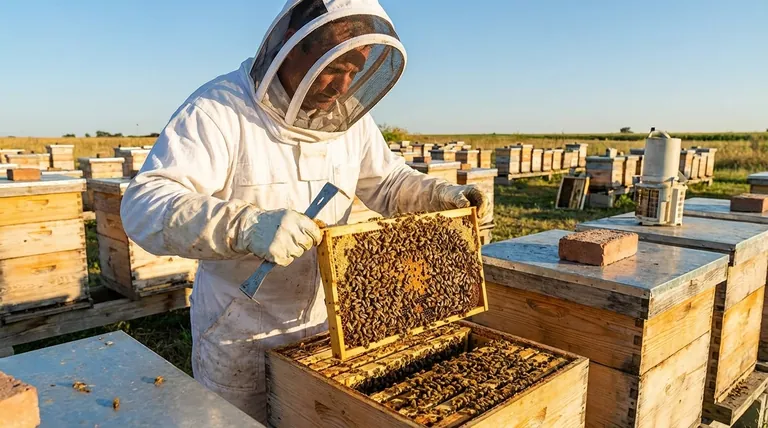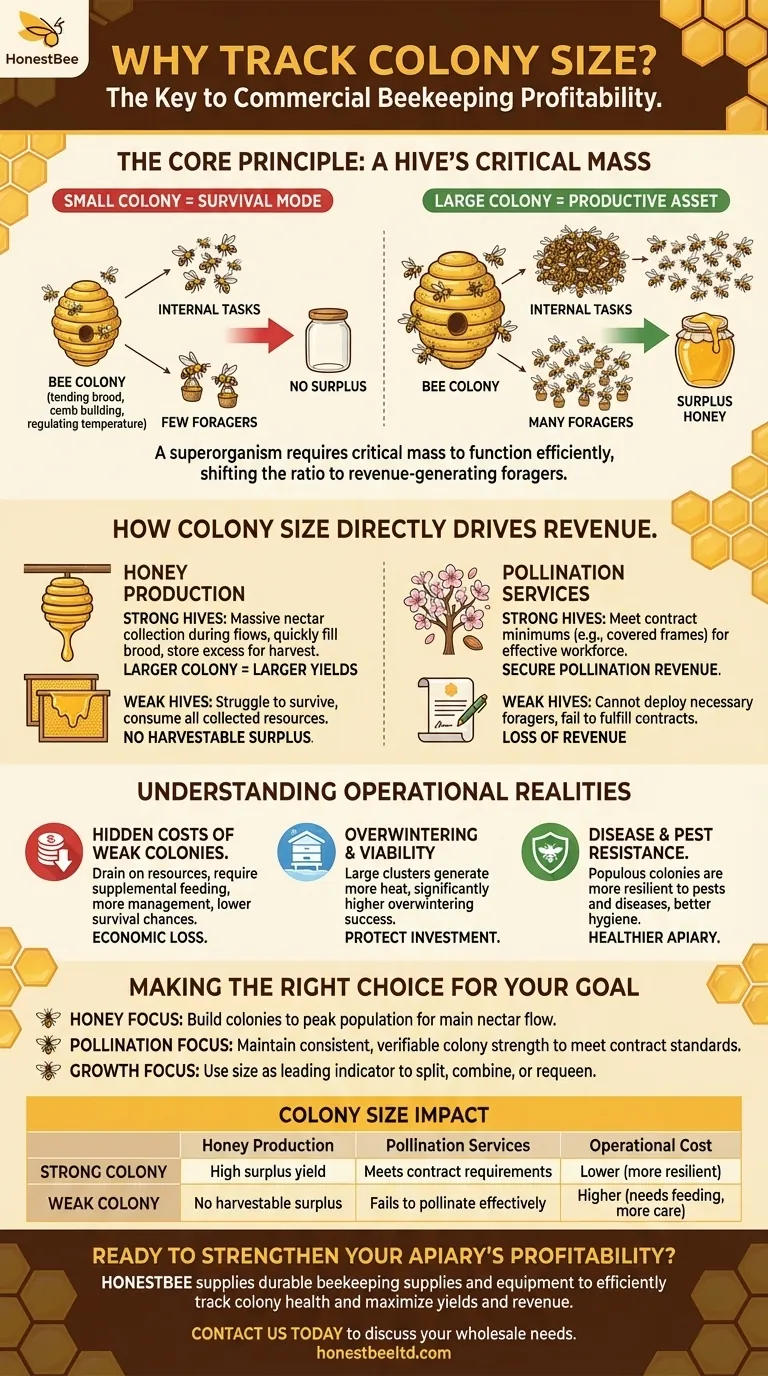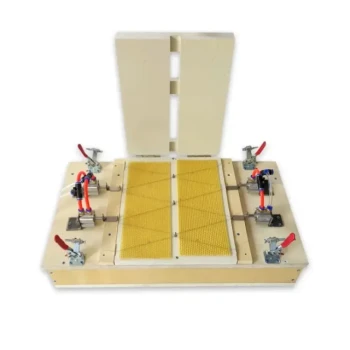For the commercial beekeeper, tracking colony size is the most critical management practice. It is the primary indicator of a hive's economic viability because only strong, densely populated colonies can generate surplus honey or provide effective pollination services—the two pillars of a successful operation.
A beehive operates like a business: it must first cover its own operational costs (feeding itself) before it can generate a profit (surplus honey). Colony size is the key metric that determines whether a hive is a productive asset or a resource-draining liability.

The Core Principle: A Hive's "Critical Mass"
A bee colony is a superorganism that requires a certain population size, or critical mass, to function efficiently. Understanding this principle is fundamental to commercial beekeeping.
The Division of Labor
A colony's workforce is divided. A significant portion of bees are dedicated to internal tasks: tending to the queen and brood, building comb, and regulating the hive's temperature.
The remaining bees are foragers who perform external, revenue-generating work by collecting nectar and pollen.
Reaching Productivity Threshold
A small colony dedicates almost its entire workforce to internal survival tasks. It has very few foragers and struggles just to feed itself, producing no surplus.
Only when a colony grows large does the ratio shift. The number of foragers explodes, allowing the hive to bring in far more resources than it consumes. This is the point where a hive becomes commercially productive.
How Colony Size Directly Drives Revenue
Profit in beekeeping is not a function of the number of hives you own, but the number of strong hives you manage. Colony size is directly correlated with the output of your two main profit centers.
For Honey Production
A weak hive might gather enough nectar to survive but will never create a harvestable surplus. It consumes everything it collects.
A strong hive, with tens of thousands of foragers, can collect a massive amount of nectar during a "nectar flow." This allows them to quickly fill their brood chamber and then store the excess as the honey you will harvest.
Therefore, larger colony size directly equals larger honey yields.
For Pollination Services
Farmers who rent beehives for pollination pay for a guaranteed workforce. Contracts specify a minimum colony strength, often measured by the number of frames covered in bees.
A small colony cannot deploy the sheer number of foragers needed to pollinate a commercial crop, like almonds or blueberries, within the short blooming period.
Failing to meet these strength requirements means failing to fulfill the contract. Strong colonies are the only way to meet pollination agreements and secure that revenue.
Understanding the Operational Realities
Beyond direct revenue, colony size dictates your operational efficiency, costs, and the overall resilience of your apiary.
The Hidden Costs of Weak Colonies
Weak colonies are a constant drain on resources. They often require supplemental feeding, more intensive pest and disease management, and have a much lower chance of surviving the winter.
Keeping a weak colony is often an economic loss. It consumes time, money, and feed without contributing to the bottom line.
Overwintering and Viability
A large population cluster is far more capable of generating the heat needed to survive cold winter months. Strong colonies have significantly higher overwintering success rates, protecting your investment in your stock.
Disease and Pest Resistance
Populous colonies are more resilient. They can better manage threats from pests like Varroa mites and are generally more capable of maintaining hive hygiene, which helps prevent disease outbreaks.
Making the Right Choice for Your Goal
Consistently evaluating colony size allows you to shift from reactive problem-solving to proactive, data-driven management.
- If your primary focus is honey production: Build colonies to their peak population to coincide precisely with the start of the main nectar flow in your area.
- If your primary focus is pollination services: Maintain a consistent, verifiable colony strength that meets or exceeds the standards defined in your pollination contracts.
- If your primary focus is sustainable growth: Use colony size as the leading indicator to decide when to split strong hives, combine weak ones, or requeen failing colonies.
In commercial beekeeping, tracking colony size is not just about animal husbandry; it is the fundamental practice of managing your most valuable production assets.
Summary Table:
| Colony Size Impact | Honey Production | Pollination Services | Operational Cost |
|---|---|---|---|
| Strong Colony | High surplus yield | Meets contract requirements | Lower (more resilient) |
| Weak Colony | No harvestable surplus | Fails to pollinate effectively | Higher (needs feeding, more care) |
Ready to Strengthen Your Apiary's Profitability?
As a commercial beekeeper or beekeeping equipment distributor, your success hinges on managing strong, productive colonies. HONESTBEE supplies the durable beekeeping supplies and equipment you need—from hive tools to monitoring systems—to efficiently track colony health and maximize your honey yields and pollination revenue.
Contact us today to discuss your wholesale needs and let us help you build a more profitable operation.
Visual Guide

Related Products
- HONESTBEE Advanced Ergonomic Stainless Steel Hive Tool for Beekeeping
- Professional Galvanized Hive Strap with Secure Locking Buckle for Beekeeping
- Economy Small Scale Honey Dryer Dehumidifier Thickening Machine
- HONESTBEE Professional Frame Wiring Board and Jig
- Heavy-Duty Galvanized Steel W-Style Pallet Clip
People Also Ask
- What is a hive tool and what are its uses? Master Your Hive Inspections with the Essential Beekeeper's Tool
- What are the features of a regular hive tool? The Essential Multi-Tool for Every Beekeeper
- How should beekeepers handle bees when using a hive tool? Master Calm, Deliberate Techniques
- What tools are used for cleaning frames? A Beekeeper's Simple 4-Tool Guide
- Why do hive tools have a hole? Unlock the Secret to Efficient Beekeeping



















